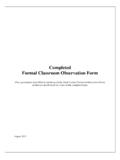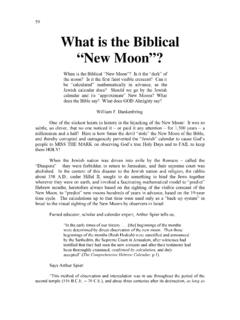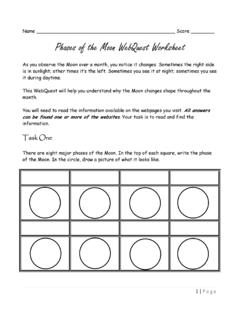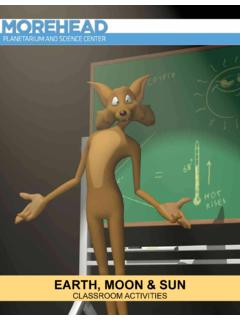Transcription of Moon Phases - VDOE
1 Science Enhanced Scope and Sequence Grade 4 virginia department of education 2012 1 moon Phases Strand Earth Patterns, Cycles, and Change Topic Investigating moon Phases Primary SOL The student will investigate and understand the relationships among Earth, moon , and the sun. Key concepts include c) the causes for the Phases of the moon . Related SOL The student will demonstrate an understanding of scientific reasoning, logic, and the nature of science by planning and conducting investigations in which b objects or events are classified and arranged according to characteristics or properties; k) data are communicated with simple graphs, pictures, written statements, and numbers; l) models are constructed to clarify explanations, demonstrate relationships, and solve needs. The student will investigate and understand the relationships among Earth, moon , and the sun.
2 Key concepts include a) the motions of Earth, the moon , and the sun. Background Information The moon generates no light of its own. It can be seen because it reflects the light from the sun. Though it does not always appear so from Earth, half of the moon is always illuminated, and the other half is always in darkness. However, as the moon orbits the Earth, its position in relation to the Earth and the sun changes, and more or less of the illuminated side may be seen from Earth. These different views are called Phases of the moon . 1. New moon : When the moon is directly between the sun and the Earth, the side of the moon facing the Earth is in darkness; hence, it is not visible in the sky. The light from the sun reflects off the moon back toward the sun; not toward Earth. This phase is called the new moon .
3 2. Waxing crescent: As the moon continues to move in its orbit around the Earth, a sliver of the illuminated side of the moon becomes visible. This phase is called the waxing crescent. (To wax is to increase.) 3. First quarter: When the moon has completed one quarter of its orbit around the Earth, it makes a right angle with the Earth and the sun. One half of the moon is still Science Enhanced Scope and Sequence Grade 4 virginia department of education 2012 2 illuminated by the sun, and the other half is still in darkness. However, from the Earth, the moon now appears to be a half circle. This phase is called the first quarter. 4. Waxing gibbous: As the moon continues in its orbit, the portion of the illuminated side of the moon visible from the Earth continues to increase. When the moon appears to be more than a half moon but less than a full moon , it is called a gibbous moon .
4 At this point in its orbit, the moon appears to be growing, so this phase is called a waxing gibbous. 5. Full moon : When the moon has completed one half of its orbit around the Earth, it is almost in a straight line with the Earth and the sun. The entire side of the moon that faces Earth is illuminated. This phase is called a full moon . 6. Waning gibbous: The darkened side of the moon begins to reappear to observers after the full moon . This phase is called a waning gibbous. The moon is described as waning when it appears to grow smaller. (To wane is to decrease.) 7. Third quarter: When the moon has completed three quarters of its orbit around the Earth, it again makes a right angle with the Earth and the sun. This phase is called the third quarter or last quarter. 8. Waning crescent: As the moon s orbit continues, the moon appears as a crescent shape once again.
5 Since it appears to grow smaller, this phase is called a waning crescent. New moon again: The darkened area continues to grow larger until no portion of the illuminated moon can be seen. The moon has returned to the new moon phase. Materials Overhead projector Eight basketballs (or equivalent size balls) Cards labeled for each moon phase and one labeled Earth Paper plates (one per student) Markers Minichocolate sandwich cookies with vanilla cream (enough for 10 per student) Note: Check for food allergies before using cookies. Toothpicks (optional) Vocabulary moon , phase, new moon , crescent, first quarter, gibbous, waxing, waning, full moon , rotation, revolution, reflection, illuminate Student/Teacher Actions (what students and teachers should be doing to facilitate learning) Introduction 1.
6 Ask students what they know about the moon . List each item on the board. 2. Ask the students if they know why the moon appears to change shape each night. Allow discussion and ideas on how this happens. 3. Tell students that today they will learn why the moon appears as different shapes each night. Science Enhanced Scope and Sequence Grade 4 virginia department of education 2012 3 Procedure 1. Turn on the overhead projector facing an open area of the room. Ask the students what it could represent in our solar system. 2. Ask a student to hold a card labeled Earth and stand in the middle of the open area. 3. Have students surround the Earth one at a time holding a basketball in front of them and facing the student representing Earth. These students will represent the moon as it revolves around Earth.
7 4. The student representing Earth in the center should describe the lighted area of the basketball in the different positions around the Earth. 5. Have different students stand in Earth s place to describe each phase and hand the appropriate moon phase card to the student holding the basketball in the appropriate spot. Discuss why they see what they see. 6. Have students draw what each phase looked like on the board. Label the Phases and discuss ways to remember the names of the Phases . 7. Hand out one paper plate and ten cookies to each student. 8. Have students take the paper plates and draw a sun on one side of the plate and Earth in the center of the plate. 9. Ask students to carefully open each of their cookies so that the vanilla cream is on one side of the cookie. Have the students scrape the vanilla cream off the one side to represent the different moon Phases (toothpicks are optional.)
8 Conclusion 1. After students have placed their cookie representations of each moon phase around the plate, have them label them on the plate. 2. Ask students what more they can tell you about the moon . Add these ideas to the list on the board started at the beginning of class. Assessment Questions o What would the moon Phases be like if neither the moon nor the Earth revolved or rotated? o What is the phase directly after a waxing gibbous? Journal/writing prompts o Jupiter has over 50 moons. Tell what you might see in the night sky. Be sure to mention Phases in your description. o How does the reflection of the sun s light on the moon help humans? Explain and give examples. Other o Have students draw representations of the moon phase you call and hold them up on dry erase boards or laminated paper.
9 O Have students sketch a moon phase model on paper illustrating the position of the sun, Earth, and all eight moon Phases . Science Enhanced Scope and Sequence Grade 4 virginia department of education 2012 4 Extensions and Connections (for all students) Have students create a moon phase calendar. Play vocabulary BINGO with the Phases of the moon terminology. Create a foldable flip book of the Phases of the moon . As students flip through the pictures, the moon Phases appear to change. Strategies for Differentiation Generate labels for students to use for the cookie activity. Provide a printed and labeled diagram for students while completing the cookie activity. Show a video clip of a time lapse version of the Phases of the moon .

















